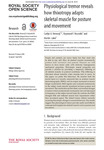Please use this identifier to cite or link to this item:
http://lib.hpu.edu.vn/handle/123456789/21899| Title: | Physiological tremor reveals how thixotropy adapts skeletal muscle for posture and movement |
| Authors: | Vernooij, Carlijn A. Reynolds, Raymond F. Lakie, Martin |
| Keywords: | Biology Physiology Behaviour Neuroscience Physiological tremor Mechanical resonance Thixotropy Posture Electromyography Muscle |
| Issue Date: | 2016 |
| Abstract: | People and animals can move freely, but they must also be able to stay still. How do skeletal muscles economically produce both movement and posture? Humans are well known to have motor units with relatively homogeneous mechanical properties. Thixotropic muscle properties can provide a solution by providing a temporary stiffening of all skeletal muscles in postural conditions. This stiffening is alleviated almost instantly when muscles start to move. In this paper, we probe this behaviour. |
| URI: | https://lib.hpu.edu.vn/handle/123456789/21899 |
| Appears in Collections: | Education |
Files in This Item:
| File | Description | Size | Format | |
|---|---|---|---|---|
| 0265_Physiologicaltremorreveals.pdf Restricted Access | 770.6 kB | Adobe PDF |  View/Open Request a copy |
Items in DSpace are protected by copyright, with all rights reserved, unless otherwise indicated.
